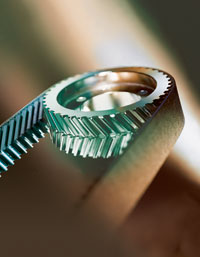
Posted to News on 25th Jun 2019, 00:00
Perfect timing
In the industrial world, timing belts are growing in popularity due to improved efficiency and reduced maintenance when compared with traditional friction belts. However, different applications have different demands, and it is crucial to consider power transmission requirements, and the environment in which the belt will operate, before deciding on a solution, as Gordon Smith of Eriks explains.

Today, engineers have a wide range of transmission belts from which to choose – from classic and banded friction belts, to variable-speed belts, V-ribbed belts and timing belts. With so many options on the market, how do you decide on the right component for the application? Traditionally, motors were operated directly on line and their speeds could not be controlled. During start-up, speeds could go from 0 to 3,000rpm or more within a few seconds. Nowadays, motors can be controlled using inverters, permitting the use of timing belts.
Nevertheless, many engineers still prefer to opt for friction belts (or V-belts). Why is this? Well, they occupy the majority of the market mainly because they are an economical option that are easy to install and replace. But the downside is that standard friction belts require more maintenance and they can degrade faster, leading to reduced performance and possible catastrophic failure. So, let’s take a look at the key issues engineers need to consider if you are considering timing belts for your application.
As a critical component of machinery, the type of belt used can directly impact the performance and longevity of equipment. The key variables to consider are how much power will be absorbed, required running speed and the service duty of the application. The operating environment is also an important factor – is it hot or cold, dusty or humid?
Timing belts are ideal for high power applications that require exact power transmission, synchronicity in running and where loads are consistent. These belt drives operate by positive tooth engagement, which leads to higher efficiency compared to friction belts. For example, timing belts are ideal for use in robotics, textile machinery, packaging machines, conveying equipment and in the printing industry. These applications often involve high speeds and small pulleys, which complement the compact design of timing belts.
One of the main benefits of timing belts is that they require less maintenance than friction belts as they don’t require high installed belt tensions. If tensioned correctly from the start, timing belts will run at 98% efficiency for the lifetime of the drive, which is typically three years, whereas friction belts need regular re-tensioning. Timing belts are also more energy efficient because they rely on tooth grip instead of friction to efficiently transfer power and provide a constant speed ratio.
Over recent years technology has developed with better, high strength materials providing timing belts with the ability to run uninterrupted for over 25,000 hours. When compared to friction belts that require periodic inspection and re-tensioning, the maintenance cost savings can really add up. The latest carbon corded belts, for example, have better length stability, are more resistant to humidity and have wider temperature ranges – minus 55°C to plus 80°C.
Despite the many advantages of timing belts outlined above, there are some applications that may be more suitable to other types of drives. For instance, direct on-line start applications can be a problem for timing belts because the sudden shock load can cause the teeth to shear and fail. In this situation, V-belts may be preferable because they will slip to absorb the shock load to some degree.
Applications in dirty, dusty environments or where debris is present in the atmosphere are also undesirable for timing belts as this can build-up on the pulley and in belt teeth, interfering with running and causing failures. Standard timing belts are also quite noisy and cause vibration, so any applications where this would be a problem traditionally would have been more suited to
V-belts. However, having said this, the development of the revolutionary Conti SilentSync means that noise related issues previously associated with conventional timing belts can now be counteracted.
Designed with an innovative helical offset tooth profile, which allows a smoother tooth engagement, the Conti SilentSync reduces noise levels by up to 19dB, whilst also delivering 20% lower vibrations and 98% efficiency – 5% more efficient than conventional V-belts.
Where noise is not an issue, many engineers have historically opted for chain drives, which can operate well at lower torque and speed, and in wet and humid conditions. The problem is that chains require frequent lubrication, which makes them more expensive to maintain. On the other hand, modern timing belts, can operate in moist environments without needing lubrication. As a result, we recommend replacing chains where possible to provide lower maintenance and more compact drives.
The vast majority of applications are suitable for both friction and timing belts. Therefore, it often comes down to a choice of a more expensive timing belt drive that will be overall more efficient, compared to its less expensive friction belt, which is less reliable and more expensive to maintain. But it is also important to consider other issues such as health and safety, in terms of noise, product availability, and whether product innovation has evolved to suit specific applications.
When considered over the lifetime of the product, the favourable option is clear. Better efficiency, reduced maintenance and a longer lifecycle mean that significant total cost of ownership savings can be made when switching to timing belts.






